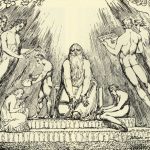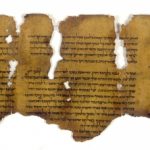Daniel’s prayer in Daniel 9 has been the subject of much debate among scholars. There are some who are of the opinion that it is not original to the text of Daniel 7-12 but is instead a later redaction to the text and was composed by a different author. Others believe it is original to the initial composition of Daniel 7-12 but comes from a well-known liturgical prayer of the time and was incorporated into the text of Daniel 9 because of the sharing of certain key words. Since most scholars subscribe to the theory that Daniel 7-12 was originally composed during the Maccabean revolt, there is minimal discussion over whether or not the historical Daniel actually composed the prayer. Most debates focus around whether or not it was added in with the original composition from an external source or whether it was a later addition like the Prayer of Azaraiah. I will be taking the position that the Maccabean dating is not an indisputable fact and will show evidence that Daniel’s prayer is not only original to Daniel 9, but that it also fits within the broader context of Daniel 7-12. I will also provide evidence that will suggest a date of composure much closer to that of the historical Daniel rather than several centuries afterwards. To accomplish this, we will analyze several of the most common arguments that support Daniel’s prayer as being a secondary addition to the text.
The origin of Daniel’s prayer (Dan 9:4a-19) and its usage within chapter 9 has been a matter of much debate. Some scholars do not find that the prayer fits the context of the chapter, however this concern typically only arises when one has a rigid view of the composition of the Biblical book.[1] Most scholars assume a Maccabean era date for at least chapters 7-12 of Daniel but there are multiple aspects of the prayer which prove problematic with this assumption. Lucas points to four main arguments used to support the view that this prayer is a secondary addition to the chapter[2]: 1) The Hebrew prayer is written in elegant, free-flowing Hebrew with traditional Biblical phrases and does not include any Aramaisms or unnecessary repetitions. This is distinct from the surrounding text in the chapter. 2) The context of the chapter (Daniel attempting to discern when exile is to end) requires a prayer for illumination, not a communal confession of sin. 3) The beginning and end of the prayer are marked with duplications which must be redactional seams. The removal of these duplications would result in a smooth transition from verse 3 to verse 21, therefore indicating that this prayer must have been an insertion into the original document. 4) The language and thought of the prayer, such as the use of the Divine name YHWH and the emphasis on Israel’s sin and her punishment, are unique to the prayer. Another suggestion is that the prayer was a well-known prayer of older origin which the author chose to include in order to unify the narrative and thus was included from an external source into the original composition of the chapter[3]. While there is an underlying assumption that chapters 7-12 was originally composed in the Maccabean era, these issues still must be addressed even if we assume that the historical Daniel was the original author. I will be taking the position that Daniel 7-12 was originally composed by the historical Daniel but will allow for the possibility of later redactions to make the prophecy more specific to the oppression by Antiochus Epiphanies IV. The subjugation of the Jewish nation by Antiochus certainly fits a fulfillment of this apocalyptic prophecy although it is general enough to fit other contexts as well.[4] This dating of the text is more appropriate for chapter 9 because the prayer focuses upon the confession of the sins of all Israel which is inappropriate for the Maccabean age as it is the evil heart of Antiochus which is the problem.[5] Rather, we should consider the prayer to be interacting with Jeremiah’s seventy-year prophecy which Daniel believes must be fulfilled prior to this apocalypse occurring.
The elegant, free-flowing Hebrew text of the prayer compared to the frequent Aramaisms and “unnecessary” repetitions of the surrounding text are not necessarily evidence of a separate source of the prayer. Reddit claims that this is evidence of different authorship with an author who was “more at home in Hebrew than the author of vv. 1-3, 21-27[6].” However, such claims are problematic. Would not the author have recognized such inconsistencies and attempted to smooth them out if he was attempting to pass off his work as having actually been composed centuries earlier? Also, if he added in a well-known prayer, as was suggested above, would he not have run the risk of someone recognizing the prayer and realizing that it was not original to Daniel? Rather, we should recognize that the prayer is written in liturgical language which is conservative by nature and it contains many well-known phrases from other parts of the Hebrew Bible[7]. The author changes from the chaotic Hebrew, which is used throughout the apocalypse, and transitions into a smooth-flowing Hebrew in order to represent the shift from the chaos of the world to the tranquility of communication with YHWH. However, even with the change in Hebrew and the usage of liturgical formulas from earlier Scripture, there are still certain words which are frequent to the other sections of Daniel which are found in the prayer. The most commonly noted word is שׁמם, “desolation”, and Williams states that in Daniel it is a “veiled-yet scathing-denunciation of Antiochus IV Epiphanes, who discontinued the regular sacrifices” and is used as a derogatory pun on the divine epithet, שָׁמֵם, בַּעַל, to whom Antiochus dedicated the Jerusalem temple.[8] This however evidences the underlying bias of a Maccabean date for the text and ignores the fact that שׁמם frequently occurs in Leviticus 26 (6x), Isaiah (9x), Jeremiah (11x), Lamentations (5x), and Ezekiel (25x) in contrast to the seven occurrences in Daniel 7-12. While it is possible that it was viewed as a pun against Antiochus’ god during the Maccabean era, this is not evidence for the original intent of its usage and requires the assumption of a Maccabean date for the prayer and the rest of the chapter. It is more probable that its usage in Daniel 9:18 (שֹֽׁמְמֹתֵ֔ינוּ, “our desolations”) is a play on the city which is “called by Your name” (שִׁמְךָ֖). Therefore, the change in Hebrew style is not necessarily indicative of different authorship and the similarities in vocabulary between the prayer and the rest of the passage provide strong indication that it is original to the text.
The claim that the context of the chapter demands a prayer for illumination and not for communal confession is also problematic. Lacocque believes this prayer to be a kind of initiation right that was understood as a prerequisite for receiving divine secrets[9]. The underlying assumption behind this proposition is that Jewish prayers were analogous to their counterparts in other nations; through magical manipulations one could control the deity. Jewish prayers however are not like this, they acknowledge that even if God doesn’t deliver them, He is still their God[10]. While Lacocque’s underlying assumption is inappropriate for Jewish prayer modes, he does go on to state that Daniel’s confession of Israel’s sins functions to remove the last obstacle on God’s road to the vindication of Israel and the chastisement of the nations[11]. This idea of sin building up and needing removal can be seen in Genesis 15:16 where Abram is informed that his descendants must suffer until the iniquity of the Amorites is complete. Thus, while Daniel seems to recognize that the time period of seventy years is complete, there is still the need for confession to remove the final obstacle for God to begin vindicating Israel. Daniel recognizes that the completion of Jeremiah’s prophecy not only includes a seventy-year punishment, but also requires the confession of the people’s sins and the sins of their fathers as found in Leviticus 26:40-42. Thus “prayer constitutes the appropriate response to Scripture” and so that prayer will contain language from those texts because “prayer naturally reflects Scripture[12].” Newsom notes that Jeremiah 29:10-14 also indicates that prayer precedes God hearing Israel[13]. Wilson has suggested that Daniel’s observation “in the scrolls” should not be understood as Daniel reading a canonized version of Jeremiah since the word used in Daniel 9:2 is בַּסְּפָרִ֑ים, “scrolls”, and “one book would hardly be called sefarim.” He points out that only in Jeremiah 27-29 is the Bablyonian monarch called Nebuchadnezzar, just as in Daniel, while the rest of Jeremiah uses Nebuchadrezzar. Based upon this he proposes that Daniel’s usage of the plural sefarim indicates a reference to the actual letter that Jeremiah sent, rather than a canonized scroll[14], which would indicate this prayer was actually composed by the historical Daniel upon receiving the letter from Jeremiah and thus a response of repentance is appropriate.
Rather than the context demanding illumination, we can see that communal confession actually fits the context of Israelite understanding of how to motivate God to take action on their behalf. Israel had violated the covenant requirements and the punishment required is not only punitive but also demands a change in heart. Scriptures never support the idea that God’s purpose will be accomplished irrespective of the prayers of His people[15] and this text is a prime example of this. The evidence that Daniel’s prayer is actually a response to Jeremiah’s letter rather than the canonical scroll provides strong evidence that this prayer originated in the historical Daniel’s time rather than in the Maccabean era.
The idea that the prayer is marked by duplications which, if removed along with the prayer, would result in a smooth transition from verse 3 to 21 thus indicating redactional seams of an insertion into the original document is a valid concern. Nelson states that this could be viewed as problematic, since the removal of the prayer would leave the rest of the chapter unusually short compared to the rest of the book. However he recognizes chapters 10-12 form one exceptionally long literary unit and so there doesn’t necessarily have to be uniformity between the lengths of literary units.[16] While Nelson is correct that the literary unit length is not a valid reason accepting the prayer, the use of duplications is not strong evidence to support redactional seams since the use of repetition is a common literary practice in Hebrew and is often used to emphasize or aid in memorization. Thus this point neither adds to nor subtracts from the debate over composition of the prayer.
The sudden shift to using YHWH and Adonai as names for God in Daniel’s prayer is rather shocking, but perhaps it is intentionally so. Certainly a redactor would have been aware of this shift if indeed Daniel’s prayer was an insertion and so the shift must be accounted for regardless of the position one takes. Lucas notes that for most of the book of Daniel, the addressees or addressors are pagan kings communicating with Daniel and thus non-Jewish modes of speech are used to refer to the God of the Jews that would be better understood by such an audience.[17] Daniel’s prayer however is not addressed to a pagan king but to Israel’s heavenly King and thus the change in name usage is warranted. Goldingay claims that the use of Adonai in the prayer is evidence of the development of the Jewish circumlocution of the name YHWH. He notes that each occurrence of Adonai in chapter 9 comes at a point where Israelite prayer would have more traditionally used YHWH; as a vocative. Instead YHWH appears in third person references and not at all in the plea.[18] The circumlocution of the name YHWH is a later development in Second Temple Judaism and thus Goldingay’s proposal fits well within the Maccabean dating which he assumes. It is not without problems however; this prayer quickly gained liturgical status for use on Yom Kippur and if the intent was to avoid the vocalization of YHWH’s name, why include the tetragrammaton at all? The avoidance of the name altogether certainly would have fit the context of the book of Daniel better. I would propose an alternative explanation: In the ancient world, names, especially those of a deity, possessed “a dynamic and were expressive of character, or attributes, and potency. The names of gods were immediately identified with their nature, status, and function.[19]” Thus, rather than a circumlocution, the switching to Adonai and YHWH functions to call upon different attributes of God. Adon/Adonai describes the one who occupies the position of a “master” over a slave or servant.[20] The name YHWH, on the other hand, is associated with the covenant promise of possession of the land of Canaan by Israel.[21] The language in the prayer functions to portray Israel as a rebellious servant who is shameful and unworthy of God’s mercy juxtaposed against YHWH’s righteousness and covenant loyalty who will act for the sake of His name because His name/reputation is attached to the covenant that He made with Israel. Thus, the use of Adonai with vocatives functions to portray Israel as the faithful servant of God in need of her master while the use of YHWH calls to attention the covenant relationship between YHWH and Israel. The usage of the two names is then to be understood as a literary device used by the author to further emphasize his confession. We must conclude then that the usage of different names for God in Daniel’s prayer is not evidence of separate authorship.
Lastly, we will investigate the manner in which Daniel’s prayer uses the concepts reputation and shame in order to provide motivation for God to act by reversing the Babylonian exile and how this fits within the greater context of Daniel 7-12. Nelson claims that this appeal to God’s reputation is boldly anthropomorphic and mirrors attempts to influence human judges by appealing to their vanity.[22] However, this fails to appreciate the honor and shame culture of the ancient world and the connection these appeals to God’s reputation have with the rest of Daniel 7-12. In these chapters, we see a continuing theme of a beast-king who publicly speaks against God (7:25, 8:8, 8:11, 8:25, 11:36), persecutes Israel (7:25, 8:13, 9:26, 11:28, 11:30, 11:33), and desecrates God’s Temple (8:12-14, 9:26, 11:31). All three of these actions are connected; speaking against the God of gods is to attempt to shame YHWH which demands a response, otherwise it will result in YHWH’s loss of honor in the public’s opinion. Through His covenant with Israel, YHWH’s honor is also attached to Israel and to the city where He places His name, Jerusalem, and to His Temple. That a foreign king is able to conquer the people, the city, and the Temple would result in a loss of honor by YHWH as it is perceived that He is too weak to protect His possessions. Glatt-Gilad points to Jeremiah 14:9 where Jeremiah’s prayer confirms that YHWH’s name/reputation is linked to His ability to save His people militarily. Israel is unable to defend herself and because “she is the community for whom Yahweh is held particularly responsible and from whom he cannot be disassociated, she asks him to act for the sake of his own (world-wide) reputation.[23]” This understanding now restores Daniel’s prayer to the context of the apocalyptic section of Daniel. There is a king who is blaspheming God’s name, ravaging His people, and trampling His city and temple. These are things that would bring shame to YHWH’s name and so in response to this threat, Daniel’s prayer shows that it is actually the whole of Israel who has acted shamefully while God has acted honorably all along. The public nature of this prayer (in that it is recorded) serves to restore God’s honor by showing why He would allow such things to occur without reciprocation. Furthermore, Daniel appeals to YHWH to act for the sake of His name/reputation, a proper motivational method for prompting response as it has strong echoes of Exodus 32:12 where Moses appeals to YHWH’s reputation among the Egyptians as a motivation for not destroying Israel in her rebellion. Thus, we must reject Nelson’s claim in favor of Glatt-Gilad’s view that YHWH has need to preserve His honor as this is more culturally sensitive as well as providing a critical connection between the content of Daniel’s prayer and the rest of Daniel 7-12.
In conclusion, we have seen how the four main objections to Daniel’s prayer being an integral part of Daniel chapter 9 have been disproven and that there is evidence within the prayer that it, along with the rest of Daniel 7-12, can be attributed to the historical Daniel rather than demanding a Maccabean era date. The use of eloquent Hebrew is appropriate to language used in prayer while the chaotic Hebrew with frequent Aramaisms reflects the chaos of the apocalyptic scenery. The context of the passage does not at all demand a prayer of illumination, rather a confessional prayer is much more appropriate to the context and to overall Jewish prayer methodology. The prayer could in fact be removed from the chapter and the text would flow smoothly and the chapter size would not be problematic, but at the same time its addition with repetitions is not necessarily indicative of a redactional addition because repetitions are common in Hebrew literature. Also, the unique usage of the Divine name, YHWH, along with the frequent Adonai, is not indicative of an external source use because the writing shifts from an external focus with pagan kings, to a more personal, intra-Israel prayer for the community where YHWH carries significance of the covenant promises of the land of Canaan/Judea while Adonai is also appropriate in expressing subordination in the master/servant relationship. Lastly, the confession that it is actually Israel who has acted shamefully and God who is honorable fits the broader context of Daniel 7-12 where an enemy is launching assaults upon YHWH’s reputation, and the requests for YHWH to act for the sake of His honor are analogous to similar requests by Moses. Thus, I would propose that Daniel’s prayer is in fact original to Daniel 9 and that it also provides evidence that the whole of Daniel 7-12 is in fact original to the historical Daniel, leaving room for later redactions to provide some links to persecution by Antiochus IV.
References
Baldwin, Joyce. Daniel: An Introduction and Commentary, Tyndale Old Testament Commentaries. Downers Grove, IL: InterVarsity Press, 1978.
Charlesworth, James. “Prayer in Early Judaism.” The Anchor Yale Bible Dictionary. Edited by David Noel Freedman. New York: Doubleday, 1992.
Glatt-Gilad, David, “Yahweh’s Honor at Stake: A Divine Conundrum.” JSOT 98 (2002), 63-74.
Goldingay, John. Daniel, World Biblical Commentary. Dallas, TX: World Books, 1989.
Jones, Bruce. “The Prayer in Daniel IX.” Vetus Testamentum Vol 18 (1968), 488-493.
Lacocque, André. “The Liturgical Prayer in Daniel 9.” Hebrew Union College Annual Vol. 47 (1976), 119-142.
Lucas, Ernest. Daniel, Apollos Old Testament Commentary. Downers Grove, IL: InterVarsity Press, 2002.
Nelson, William. Daniel, Understanding the Bible Commentary Series. Grand Rapids, MI: Baker Books, 2012.
Newsom, Carol. Daniel, A Commentary. The Old Testament Library. Louisville: KY, 2014. Kindle Edition.
Reddit, Paul. “Daniel 9: Its Structure and Meaning.” The Catholic Biblical Quarterly 62 (2000), 236-249.
Sarna, Nahum. Exodus, The JPS Torah Commentary. Philadelphia: Jewish Publication Society, 1991.
Tremper Longman III, Daniel, The NIV Application Commentary. Grand Rapids, MI: Zondervan Publishing House, 1999.
Vine, W. E., Merrill F. Unger, and William White Jr., Vine’s Complete Expository Dictionary of Old and New Testament Words. Nashville, TN: T. Nelson, 1996.
Walton, John H. Zondervan Illustrated Bible Backgrounds Commentary (Old Testament): Genesis, Exodus, Leviticus, Numbers, Deuteronomy, vol. 1. Grand Rapids, MI: Zondervan, 2009.
Williams, Tyler. “(šāmēm I),” New International Dictionary of Old Testament Theology & Exegesis. Edited by Willem VanGemeren, Grand Rapids, MI: Zondervan Publishing House, 1997.
Wilson, Gerald. “The Prayer of Daniel 9: Reflection on Jeremiah 29.” JSOT 48 (1990), 91-99
Footnotes
[1] Longman, Daniel, 218.
[2] Lucas, Daniel, 232-233.
[3] Newsom, Daniel, Location 8177-8201 of 16,510. Also Reddit, “Daniel 9: Its Structure and Meaning,” 242.
[4] Kissling, Daniel Class Lectures, 2016.
[5] Wilson, “The Prayer of Daniel 9,” 92.
[6] Reddit, “Daniel 9: Its Structure and Meaning,” 242.
[7] Jones, “The Prayer in Daniel IX,” 489-490.
[8] Williams, “(šāmēm I),” 169.
[9] Lacocque, “The Liturgical Prayer in Daniel 9,” 121.
[10] Charlesworth, “Prayer in Early Judaism,” 449.
[11] Lacocque, “The Liturgical Prayer in Daniel 9,” 122-123.
[12] Goldingay, Daniel, 264.
[13] Newsom, Daniel, Location 8263 of 16,510.
[14] Wilson, “The Prayer of Daniel 9,” 92-93.
[15] Baldwin, Daniel: An Introduction and Commentary, 184.
[16] Nelson, Daniel, 221.
[17] Lucas, Daniel, 233.
[18] Goldingay, Daniel, 240.
[19] Sarna, Exodus, 31.
[20] Vine, et al. Vine’s Complete Expository Dictionary, 140.
[21] Walton, ZIBBCOT: Genesis, Exodus, Leviticus, Numbers, Deuteronomy, 184.
[22] Nelson, Daniel, 228.
[23] Glatt-Gilad, “Yahweh’s Honor at Stake,” 68.








